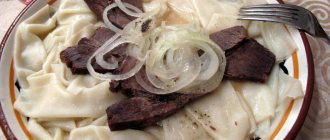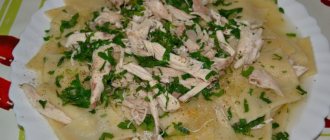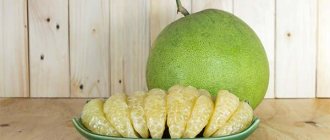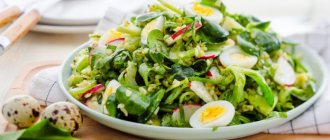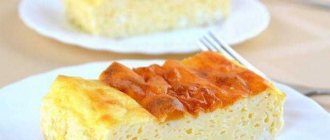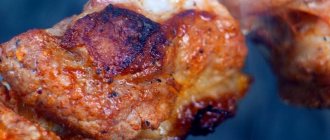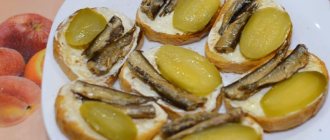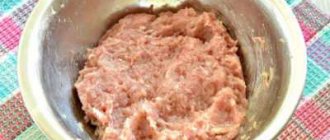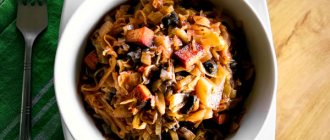Beshbarmak is a very tasty Asian dish of meat and boiled dough, flavored with onions and herbs, washed down with a strong, rich broth. It is prepared at home from horse meat, lamb and beef. How exactly you can prepare a delicious and satisfying classic beshbarmak recipe, you will find out if you read our recipes for its preparation with photos. Let's get started creating this delicious dish.
Beshbarmak, translated from Turkic languages, means “five fingers” - nomads ate this dish with their hands.
Traditional preparation of beshbarmak
In many remote areas, the tradition of preparing beshbarmak for each guest is still preserved. It doesn’t matter what time the guest arrived, be it early in the morning or at night. They immediately begin to slaughter the lamb.
The freshest and best is selected for the dish. The meat is selected not from just one variety, but from at least three. Definitely lamb, beef, horse meat. It is considered especially chic to add homemade horse sausage, as well as liver and other pieces of meat to the dish. Noodles for beshbarmak are always freshly prepared to ensure they are fresh.
How to serve beshbarmak correctly
There are 2 serving techniques.
- Classic - place prepared meat, vegetables and homemade noodles in separate dishes and place on the table. Give each guest a plate in which he will assemble his beshbarmak, adding the amount of filling he needs. Place bowls nearby with the broth in which the meat was cooked (not the dough!) According to tradition, the dish should be washed down with broth.
- Portioned - take deep plates. Place 2-3 leaves of homemade noodles in each, place meat on top, and then vegetables. Pour enough broth into the dish to lightly cover the noodles. Serve sprinkled with cilantro or parsley.
Eating food also has its own rules. Everyone sits down at a large table. First, the guests are treated to the dish, choosing the best pieces for them. Then the dish is distributed to all family members according to seniority. Traditionally, beshbarmak is not eaten with cutlery; the meat is wrapped in flatbread and washed down with shurpa.
Beshbarmak is prepared in Kazakhstan, Bashkortostan, Tatarstan, and Kyrgyzstan. Every nation calls it its national dish. One thing is undeniable: beshbarmak is a very tasty and satisfying dish. In ancient times, he repeatedly saved entire tribes of nomads from starvation.
In national cuisines[ | ]
In national cuisines, beshbarmak is known under different names - kullama
,
turama
,
tuuralgan et
,
naryn
, etc.
In Bashkir and Tatar cuisines[ | ]
Bashkir Bishbarmak
In the work of I. I. Lepekhin “Continuation of the daily notes of the travel of academician and medicine Doctor Ivan Lepekhin in different provinces of the Russian state in 1770” about beshbarmak there is: “ Bish Barmak, the best Bashkir food, comes from the word “Bish” - five , and “Barmak” is a finger, and consists of finely chopped pieces of horse, cow or sheep meat, and Salma. Salma is made from hard dough of wheat, barley or spelled flour, which, divided into pieces the size of a copper five-kopeck piece, is boiled in the same cauldron with meat, just like we have klutski
"[19].
Among the Bashkirs, along with the widespread name bishbarmak
, in some areas the dish had other names -
kullama
,
halma
,
halmaly it
or simply
ash
.
Traditionally, to prepare bishbarmak, the Bashkirs used lamb or horse meat, always on the bone. It was permissible to simultaneously use several types of meat in cooking, including veal and goose. The meat, cut into pieces, was placed in a cauldron with cold water and brought to a boil. After removing the foam, the cauldron was covered with a lid and continued to cook the meat over low heat for 2-2.5 hours. Before finishing cooking the meat, the top broth was poured out. It was used later to drizzle the noodles. The finished cooked meat was cooled slightly and cut into pieces. Also, during preparation, horse sausage cut into circles, fresh or dried horse intestines, as well as fat removed from the horse’s scruff could be used.
To prepare the noodles, hard-boiled egg dough was used, which was cut into small diamonds or squares. The noodles prepared in this way were boiled in a small amount of broth or water, flavored with broth fat (or butter) and combined with the prepared meat part of the dish. Ethnographic studies note the peculiarities of the ceremony of treating this dish that existed among the Bashkirs.
So I. G. Georgi about
.
A detailed description of the ceremony is given by S.I. Rudenko[20]. Before treating guests to bishbarmak, the hosts spread a tablecloth over the felt (Bashk. ashyaulyҡ). Next, everyone present washed their hands. To do this, either the owner himself or his adult son walked around the participants of the meal with a jug (kumgan) or a basin. After washing their hands, the guests sat around the tablecloth, on which bishbarmak was already served in large wooden cups. In each such cup, along with small pieces of lamb, fat and noodles, there were also large pieces of meat, and sometimes sausages (kazy, bashk. ҡаҙы). One of the guests was given a knife, with which he divided large pieces of meat or sausage into pieces, which the other guest distributed to those present at the meal. During the meal, the owner had to take care of treating the guests. It is noteworthy that during the meal it was customary to put the best, fatty pieces into the mouths of their neighbors or those whom they wanted to honor. Spectators not participating in the meal and children were treated in the same way. After the bishbarmak was eaten, the host of the feast drank from a cup of soup seasoned with cheese (kurut, in English) and passed it to one of the guests, usually an honorary one. The guest, like the host, drank a little from the cup, and then passed it to his neighbor, and the cup thus went around all the participants in the meal. After this, those present said a prayer of thanks with a bow, stood up, washed their hands again and, making themselves comfortable, proceeded to drink kumis or tea.
In Tatar cuisine, the name bishbarmak
or
kullam
[21]. N.I. Vorobyov, describing this dish among the Tatars, o[22].
In Karakalpak, Nogai and Turkmen cuisines[ | ]
Among the Nogais (a people in the North Caucasus of the Kipchak group of Turkic languages), the dish is called “turoma”[23], which translates as “kroshevo”. A similar dish of Karakalpak cuisine is called “turama” and is finely chopped meat with chopped dumplings[24]. For dumplings, mainly jugar flour is used. The boiled meat is finely chopped by adult men, and the dumplings are crumbled by the rest of those present. After this, the finely chopped dumplings and meat are mixed. For three or more people, turama is served on a common platter, with broth added to the dish on top. Along with the broth, a sauce is sometimes poured into the turama - the so-called tuzlyk, or serebe (a mixture of chopped onions and fat from cooked meat). Turkmen “dograma” is prepared from boiled lamb, a special thin flatbread “dograma-chorek” and onions. All ingredients are crushed, mixed, poured with broth and seasoned with ground pepper.[25]
In Kyrgyz cuisine[ | ]
Cooking lamb in a cauldron Crushed meat for beshbarmak Making noodles for beshbarmak using a noodle cutter Chyk is a sauce for beshbarmak from thinly sliced onions simmered in fatty meat broth.
Shorpo - Beshbarmak broth (Kirg. tuuralgan et, beshbarmak - crumbled meat, beshbarmak) - one of a set of dishes in the traditional ritual of serving meat[10]. Beshbarmak is prepared on the occasion of family holidays (Kyrgyzstan) or for treating dear guests. For this purpose, a sheep is slaughtered (cows and horses are also slaughtered for a large number of guests), the cut meat is boiled in a large cauldron - a cauldron. While the meat is boiling (in high altitude conditions this takes 2.5 - 3 hours), guests are served a quickly prepared dish, kuurdak - roast meat.
Before beshbarmak, each guest in a large bowl (Kyrgyzstan kese, badybot) is served with broth (Kyrgyzstan shorpo/sorpo) and meat on the bone (Kyrgyzstan zhilik/ustukan). Twelve ustukans come out of a lamb carcass (in order of decreasing importance): 1. Zhambash
(rump, upper part of the hind leg) - 2 pcs 2.
Kashka zhilik
(rump, thigh part) - 2 pcs 3.
Zhoto zhilik
(back shank, thigh part) - 2 pcs 4.
Dala
(shoulder with meat) - 2 pcs 5
Kun zhilik
(humerus with meat) - 2 pcs 6.
Kary zhilik
pcs The most respected woman (usually the wife of the most respected aksakal) is served
kuimulchak
(rump with fat tail fat).
According to custom, if there are more than twelve guests, the hosts must slaughter another sheep. Sometimes boiled, smoked or dried horse meat is added to lamb. On special occasions, a scorched and boiled ram's head is served at dastarkhan (the ears, tongue, eyes, cheeks, and palate are eaten). These parts of the head, just like the ustukans, are distributed among the guests according to age and position. The respected aksakal or the oldest guest (in different regions, in different ways, in the Naryn and Issyk-Kul regions to the youngest) is served a lamb's head (in addition to ustukan), and he, in turn, treats the rest with parts of the lamb's head with various wishes. Along with meat and fat tail (Kirg. kuiruk), by-products can be boiled - liver (Kirg. boor), lungs, stomach, as well as semi-finished products from horse meat: karta
- intestine turned fat inward,
chuchuk
- sausage from a whole strip of flank along with fat ( Kyrgyz Kazy).
Boiled fat tail and liver (Kyrgyzstan kuiruk-boor) are cut into slices and served to all guests. The stomach and lungs, cut into narrow strips, are seasoned with spices and intertwined with washed intestines. This appetizer is called dzhergyom
(Kyrgyzstan zhorgom), when boiled, it is served at dastarkhan along with beshbarmak and other meat.
Cooking meat for beshbarmak is the responsibility of men; women make noodles. The boiled meat is chopped up by men, usually younger ones. Sitting at the dastarkhan, they crumble it, holding it suspended in one hand, and with the other hand, finely cutting the meat with a sharp knife across the grain. If a horseman does not know how to chop meat, then they may say about him “atasy uyrotkon emes da” - “his father did not teach him.” This is a bad comment about the man, it also hurts his father's name greatly. The crumbled meat is mixed with thinly sliced noodles boiled in broth (Kirg. kesme/kamyr) with the addition of sauce (Kirg. Chyk) based on fatty meat broth with poached finely chopped onions and ground black pepper (Kirg. Murch)[26]. In the Talas region, the rolled out dough for beshbarmak is first boiled and only then cut into thin noodles. Beshbarmak is served at dastarkhan on a large round dish (Kyrgyz tobacco).
After beshbarmak, tea or ak-serke
- broth seasoned with fermented milk products (kumys, ayran or syuzmo).
In the south of Kyrgyzstan, serving meat (ustukanov, etc.), as a rule, is not accompanied by beshbarmak.
The predecessor of beshbarmak is considered to be the naaryn
[27], which does not contain noodles.
In Uzbek, Uyghur and Kazakh cuisines[ | ]
Uzbek (Uzbek norin, norin) and Kazakh naryn are prepared in almost the same way as Karakalpak turama. On major holidays, horse meat is used, and kazy sausage is also added .
. In other cases, lamb or beef is used. In Uzbek and Kazakh cuisines, the dish is prepared, as a rule, only by women. Since the dough for naryn is cut into thin noodles after cooking, this dish is sometimes served cold. The Uzbek Naryn is most popular in the Tashkent region. Uyghur nerin is prepared in the same way as Kyrgyz beshbarmak, that is, the dough is cut into thin noodles before cooking, and not after[28].
Meat in Kazakh style[ | ]
In Kazakhstan, beshbarmak is mistaken [ source not specified 37 days
] call the Kazakh dish
et
(meat in Kazakh).
Kazakh et with potatoes Kazakh et Kokchetav style Et made from lamb
Kazakh et is one of the main dishes of Kazakh national cuisine, prepared on special occasions.
Kazakh meat consists of boiled meat, noodles (Kazakh shelpek/zhaima - in the north, kamyr - in the south[29]) in the form of large rectangles and strong broth. Meat can be from “four types of livestock” (Kazakh tort tulik mal) - lamb, beef, horse meat and camel. According to tradition, a sheep is supposed to be specially slaughtered before a guest arrives, and the festive dish must contain horse meat. Boiled meat can be stewed with herbs and onions before serving. Along with the meat, semi-finished horse meat products (kazy, shuzhuk, zhal, zhay) and potatoes can be boiled.
In the north (North Kazakhstan, Akmola regions), northeast (Pavlodar region), south (Zhambyl region), in winter it is prepared mainly from horse meat. Horses are specially fattened for slaughter (Kazakh sogym), which is traditionally carried out for four people, according to the number of legs of the horse. The meat is divided evenly into four equal shares, which, after drawing lots, go to those participating in the slaughter. Large pieces of thinly rolled dough and cooked in meat broth and pieces of meat are placed on a wide dish (Kazakh tabak). Each piece of meat is placed in accordance with the status of the people to whom the dish is served. Et from horse meat traditionally consists of: a piece of meat with part of the pelvic bone (Kazakh zhanbas), a vertebra from the thoracic part of a horse (Kazakh uzyn omyrtka), lard from under the mane (Kazakh zhal), specially salted meat with fat (Kazakh. zhaya), salted and dried rib with a strip of meat and fat from the peritoneum inside the horse intestine (Kaz. kazy), turned inside out (fat inside) colon (horse) (Kaz. karta). Also in Et they put traditional horse meat sausage (Kazakh shuzhyk), pieces of boneless meat (Kazakh kesek et), liver (Kazakh bauyr), pieces of tripe (Kazakh karyn). The dish is poured with sauce (Kazakh tuzdyk), which is prepared as follows: chop the onion into half rings and place in a small saucepan, add pepper and salt to taste, pour in hot meat broth and simmer. In winter, it is served with sauce (Kazakh kurt-kozhe), which consists of “kurt” dissolved in hot broth. Sauces are served, as is the broth (where the meat and dough were cooked) sorpa. In the south of Kazakhstan, it is customary to serve sorpa in large bowls during meals.
Lamb eats can also be served as whole pieces of meat and are served in the following order:
- 1 - head of a ram, before cooking it is very thoroughly cleaned (the wool is burned off, the horns and teeth are removed, the lower jaw is separated along with the tongue). Cook in a separate bowl.
- 2 - pelvic bone (Kazakh zhanbas) together with part of the fat tail
- 3 - ribs with flank (Kaz. kabyrga)
- 4 - femur (Kazakh asykty zhilik)
- 5 - lumbar vertebrae (kaz. beldeme)
- 6 - liver (Kazakh bauyr)
- 7 - shoulder blade (Kazakh zhauryn)
The guests themselves determine which of them will cut the meat (most often the younger participant in the meal cuts the meat), usually in villages where they have known each other for a long time, someone is already assigned to this role.
In the east, south and west of Kazakhstan, et is served at the table in the form of noodles boiled in meat broth (served along with the broth), on top of which is laid out meat cut into wide and thin slices, chopped onion into rings, everything is poured on top with fat skimmed from the broth, in In the southern regions, chopped tomatoes are added. In western Kazakhstan, such broth is prepared separately and served directly on the table before the meal.
In western Kazakhstan, the dish can be prepared from sturgeon fish.
